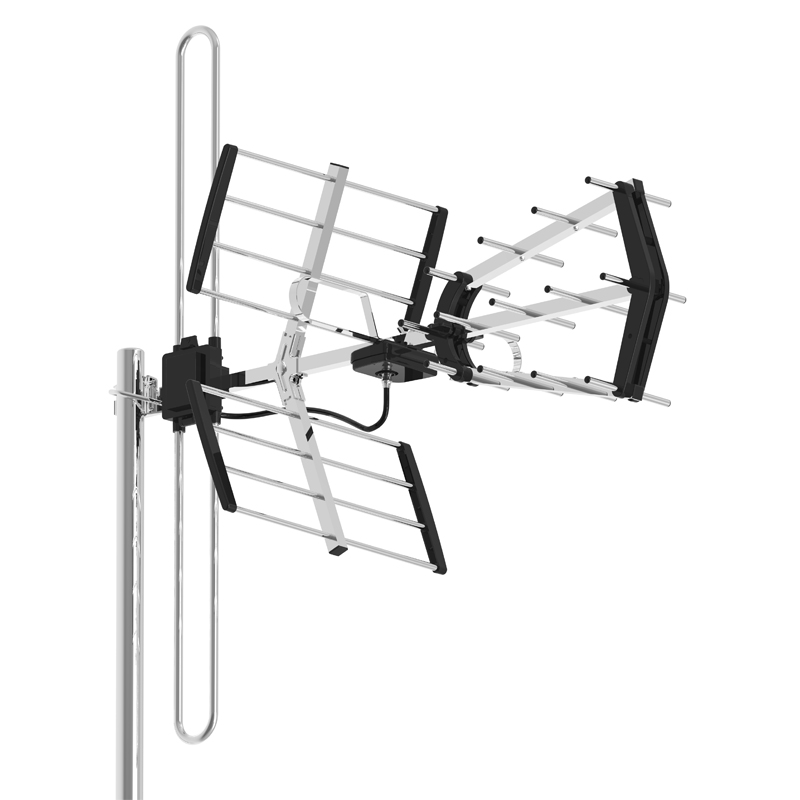Search by posts
Product category
News
 By Admin
By Admin
What factors should be considered when choosing between VHF and UHF outdoor passive TV antennas?
When choosing between VHF and UHF outdoor passive TV antennas, several factors should be considered to ensure optimal reception:
Frequency Bands: The differentiation between VHF and UHF frequency bands underscores the importance of spectrum awareness. Beyond merely recognizing the frequency ranges associated with VHF (54-216 MHz) and UHF (470-890 MHz), it's crucial to grasp the implications of these allocations on signal propagation and antenna design. VHF signals, characterized by longer wavelengths, exhibit distinct propagation behaviors compared to shorter-wavelength UHF signals. Consequently, antenna selection hinges on aligning with the intended frequency band, factoring in considerations such as wavelength reception efficiency and antenna size requirements.
Signal Strength: Signal strength assessment transcends mere signal detection, encompassing a nuanced evaluation of signal quality, reliability, and variability across different frequency bands. Leveraging signal strength mapping tools, propagation models, and empirical signal measurements empowers users to gauge the robustness of VHF and UHF signals in their locale.
Antenna Gain: Antennas boasting higher gain values wield enhanced sensitivity and directive capabilities, amplifying received signals while mitigating noise and interference. However, the pursuit of elevated gain must be balanced against considerations such as antenna size, beamwidth, and mounting requirements. Users must weigh the trade-offs inherent in high-gain designs, including increased susceptibility to multipath interference and directional constraints, to align antenna selection with their reception objectives effectively.
Terrain and Obstacles: Terrain topology and environmental obstructions exert a profound influence on signal propagation dynamics, warranting a meticulous terrain analysis to inform antenna deployment strategies. By scrutinizing terrain profiles, mapping foliage densities, and identifying potential signal attenuators such as buildings and natural barriers, users can anticipate signal propagation challenges and tailor antenna selection and placement accordingly. Recognizing the differential impact of terrain characteristics on VHF and UHF signals enables users to implement targeted mitigation measures, such as elevation adjustments, antenna orientation optimization, and obstacle avoidance strategies, to optimize signal reception performance.
Distance to Towers: Proximity to broadcasting towers emerges as a pivotal determinant of signal reception quality, with signal attenuation and coverage variability contingent on transmission distance and line-of-sight considerations. While VHF signals exhibit greater resilience to distance-related attenuation compared to UHF signals, users must assess the spatial distribution of broadcasting infrastructure and account for potential signal degradation factors such as path loss, atmospheric conditions, and terrain irregularities. By reconciling transmission distance considerations with antenna selection criteria, users can optimize reception performance while navigating the complexities of signal propagation in diverse geographic contexts.
Multipath Interference: The specter of multipath interference looms large in urban environments, where signal reflections and scattering phenomena engender signal distortion and reception degradation. Differentiating between coherent and incoherent multipath interference elucidates the nuanced mechanisms underpinning signal degradation, informing targeted interference mitigation strategies. Users must assess the susceptibility of VHF and UHF signals to multipath effects, discerning frequency-specific interference patterns and implementing mitigation measures such as antenna polarization diversity, spatial filtering, and signal equalization techniques to safeguard reception integrity.
VHF and UHF outdoor passive TV antenna, Dvb-T2HD television antennasa HD-16BJUV
Use for 168-862MHz system.
Digital television transmission system.
Cable TV wireless receiving.

 English
English Español
Español










